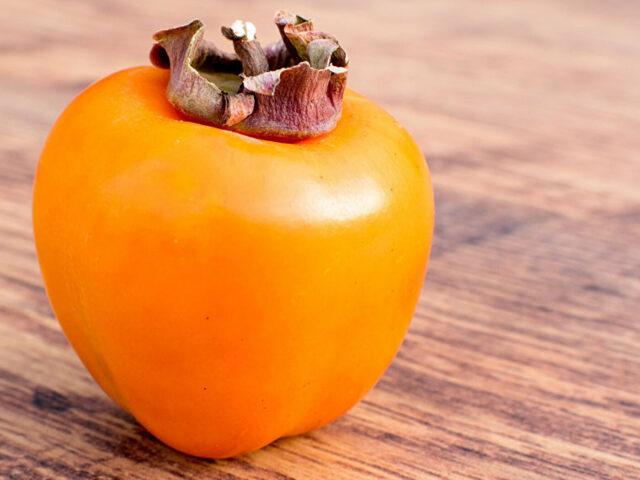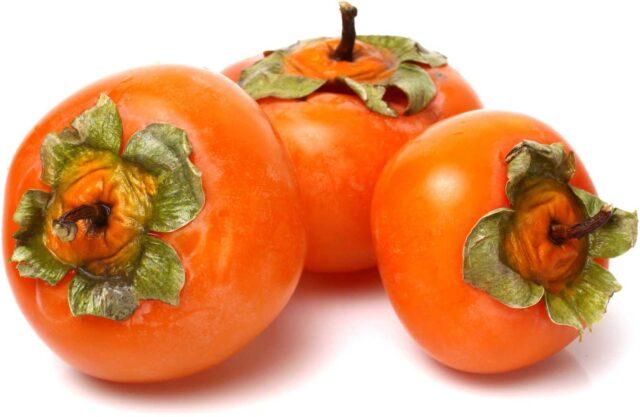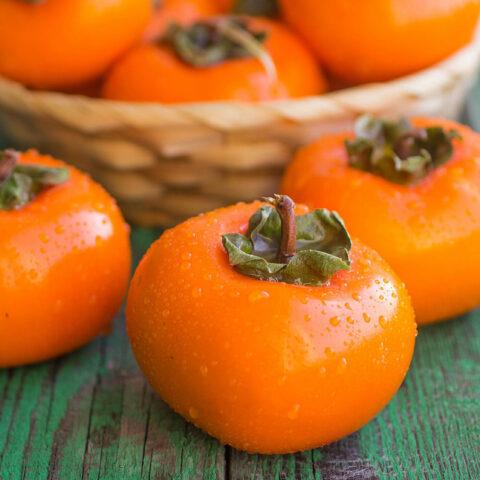Content
Persimmons with diabetes mellitus are permissible for food, but only in limited quantities (no more than two pieces per day). Moreover, you need to start with half of the fetus, and then gradually increase the dose, observing the state of health.
Chemical composition and calorie content of persimmon
The benefits and harms of persimmon in diabetes are determined by its chemical composition. The fruit contains sugars and other organic compounds:
- vitamins C, B1, B2, B6, B12, PP, H, A;
- beta carotene;
- trace elements (iodine, manganese, calcium, molybdenum, potassium, iron, calcium, sodium, phosphorus, chromium);
- organic acids (citric, malic);
- carbohydrates (fructose, sucrose);
- tannins;
- alimentary fiber.
Due to the high sugar content, the calorie content of the fruit is 67 kcal per 100 g or 100-120 kcal per 1 piece. Nutritional value per 100 g of pulp:
- proteins - 0.5 g;
- fats - 0.4 g;
- carbohydrates - 15.3 g.
Glycemic index of persimmon
The fresh glycemic index of this fruit is 50. For comparison: sugar and banana - 60, plum - 39, fried potatoes - 95, custard - 75. Index 50 belongs to the moderate category (low - less than 35, high - more than 70). This means that if persimmon is consumed for diabetes, it has a moderate effect on increasing blood sugar levels.
Insulin is also produced in moderation (persimmon insulin index is 60). For comparison: for caramel - 160, for fried potatoes - 74, for fish - 59, for oranges - 60, for durum pasta - 40.
How much sugar is in persimmon
The sugar content in persimmons averages 15 g per 100 g of pulp. It is present in the form of two carbohydrates, sucrose and fructose. These are simple sugars that are quickly absorbed and raise blood glucose levels. At the same time, in one fruit with an average weight of 150 g, their content reaches 22–23 g. Therefore, in case of diabetes, persimmon should be consumed in moderation.

One persimmon contains more than 20 g of sugar, so with diabetes it can only be consumed in limited doses.
Can diabetics eat persimmons
It is impossible to answer this question unambiguously, since much depends on the specific diagnosis (type 1 or type 2 diabetes, prediabetes), the patient's condition, age, and diet. There are some general guidelines:
- There are no categorical contraindications for the use of persimmons in diabetes: in limited quantities (up to 50-100 g per day), the fruit can be included in the diet.
- This fruit contains quite a lot of sugar. Therefore, before including it in a permanent diet, you need to consult a doctor.
- Persimmon for diabetes is introduced into the menu gradually, starting from 50-100 g per day (half the fruit).
- After that, the reaction of the body is monitored and a dose that is safe for health is determined.
- In the future, when eating a fruit, this dosage is always observed, and it is better "with a margin", i.e. 10-15% below normal. Daily use of fruits in large quantities (more than 2 pieces) is definitely not worth it.
The benefits of persimmon for diabetes
Due to its rich chemical composition, the fruit saturates the body with microelements, normalizes metabolism, digestive processes. This has a positive effect on different organ systems:
- Reducing swelling due to a mild diuretic effect.
- Improvement of blood flow, which leads to a decrease in the chances of developing such pathologies as ulcerative lesions of the feet, ketoacidosis, microangiopathy.
- Normalization of the nervous system (due to B vitamins).
- Increase of immunity and general tone of the body.
- Accelerated wound healing.
- Cancer prevention.
- Stimulation of the heart, prevention of atherosclerosis (clogging of blood vessels with cholesterol).

In limited quantities, korolek is beneficial for diabetes
For type 2 diabetics, persimmons can also provide certain benefits due to the beta-carotene it contains. It is he who provides a bright orange color. Research shows that this substance can help reduce the risk of developing the disease. But it is also found in other foods that are less rich in sugar, such as carrots. Therefore, persimmons should not be considered as the main source of beta-carotene.
There is also a lot of chromium in lentils, barley, beans, many types of fish (chum salmon, sprat, herring, pink salmon, tuna, peled, flounder and others).
Rules for the use of persimmons for diabetes
With diabetes of any type, sweet fruits are introduced into the diet gradually and the reaction of the body must be monitored. Moreover, observations are carried out regularly for several weeks to make sure that eating the fruit really does not harm.
Persimmon for type 1 diabetes mellitus
Although this form of the disease is usually more difficult, it is easier to compose a diet, since the sugar level is maintained by artificial administration of insulin. Therefore, patients can even try to eat half of the fruit per day (50-100 g) even without the consent of the doctor and measure the glucose level using a glucometer.
Then, in case of urgent need, insulin is injected, the amount of which can be easily calculated independently by the weight of the fruit (in terms of pure sugar - 15 g per 100 g of pulp). In extreme cases, when the body's production of its own insulin is reduced to zero, the use of any sugar-containing foods is categorically excluded.
Relaxation is not allowed very often, depending on the condition of the patient and the degree of neglect of the disease.

In type 1 diabetes, persimmon is introduced into the menu gradually, starting from 50 g per day.
Persimmon for type 2 diabetes
In this case, the use can be started with a slightly larger amount - from one fruit per day (150 g). Then you need to take a measurement with a glucometer and assess your condition. Such studies take several days. If the state of health does not change, fruit can be eaten in small quantities - up to two pieces a day. At the same time, they should not be consumed daily, especially since there will be other sources of sugar along with persimmon.
Persimmon for gestational diabetes
With diabetes that occurs during pregnancy, sugary foods can only be consumed with the permission of a doctor. If glucose levels are high, fruit should not be used. If the indicator is close to normal, then you can eat only in small quantities - up to one fruit per day.
Persimmon with prediabetes
In a pre-diabetic state, fruits can be included in the menu, but only in limited quantities, for example, up to two fruits per day. The diet is recommended to be agreed with the doctor.
Persimmon recipes for diabetics
Persimmons can be eaten in small quantities for diabetes. And not only in pure form, but also in combination with other useful products. You can take such recipes as a basis.
Fruit and vegetable salad
To prepare the salad, take:
- tomatoes - 2 pcs.;
- persimmon - 1 pc.;
- green onions or lettuce leaves - 2-3 pcs.;
- freshly squeezed lemon juice - 1 tbsp. l .;
- walnuts - 20 g;
- sesame seeds - 5 g.
The salad is prepared as follows:
- Walnuts are chopped with a knife or in a blender.
- Fry them in a dry frying pan (no more than two minutes).
- Cut the pulp of tomatoes and fruit into equal slices.
- Chop greens.
- Then combine all the components and pour over with lemon juice. For taste, you can also add low-fat yogurt without sugar (2-3 tablespoons).
- Sprinkle with sesame seeds for decoration.
Sauce for meat and fish
This dish, which can be used for diabetes, is also called chutney. It is a sauce that is served with meat and fish dishes. Can be used for salads, scrambled eggs and any side dish. Ingredients:
- persimmon - 1 pc.;
- sweet onion - 1 pc.;
- ginger root - a small piece 1 cm wide;
- hot chili pepper - ½ pc.;
- freshly squeezed lemon juice - 2 tbsp. l .;
- olive oil - 1 tbsp l .;
- salt to taste.
Cooking instructions:
- Grate the persimmon or chop finely with a knife.
- Chop the onion with the same pieces.
- Finely chop the flesh of the pepper (pre-pitted).
- Grate the ginger root.
- Combine all products.
- Drizzle with lemon juice and olive oil.
- Taste, add salt to taste.
Overripe fruits will spoil the consistency, and greenish ones will give an unpleasant astringent taste.

The prepared sauce can be stored in the refrigerator for 3-4 days.
Conclusion
Persimmons for diabetes mellitus are allowed to be consumed in moderation. But if the patient has a complex form of the disease, he must first consult a doctor. Also, pregnant and lactating women should get advice - changing the diet on their own can harm their health.







